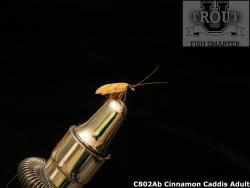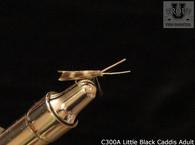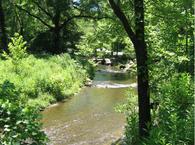
There are two basic types of caddisflies that's determined by their larva - cased and non-cased. Cased caddis are easy to identify in their larval stage of life. They live in a case made of wood or small stones or rocks. Non-cased caddis larva is one of two different types. They are either free living caddis larva or net-spinning caddis larva.
The giant Hydropsychidae family are all net-spinning caddisflies. That means they catch the food they eat in tiny nets they produce. These little nets are strung out on a silk line from shelters the larvae build to reside in when they are not eating food from their nets.
Streams with a high pH have lots of algae. Streams with low pH levels have little algae. For example, much of the water in Abrams Creek comes from underground (spring creek water) and has a higher pH than the other streams in the Smoky Mountains National Park. The tailwaters of the Southeast and many other streams in the USA have a high enough pH to contain enough algae to support good populations of net-spinning caddisflies.
The Cinnamon Caddisflies are found to some extent in most of the trout streams in the Eastern United States as well as some Mid-Western streams and is the most common caddisfly found in the Eastern United States. It has a very long hatch time that last up to three months on some streams. It is a net-spinner that is found in tailwaters and free-stone streams. Imitations of this one is a must for Eastern anglers. Keep in mind some anglers also call some of these Spotted Sedges. For the most part its Cinnamon Caddis in the East and Spotted Sedges in the West even though the genus are different. The Cinnamon Caddisflies will be the main subject of a future blog.
In addition to the Cinnamon Caddis listed below are the species of Caddis available in the TroutU Perfect Fly series:
The Great Autumn Brown Sedge is also called the Fall Caddis or the October Caddis and Great because it is large. Obviously with a name like October Caddis, they can be found in the Eastern and Mid West of the USA in the months of September and October. The habitat for these caddis flies is fast moving, clear mountain water usually where there are a lot of woods. At an approximate hook size of 10, they provide a good meal for a trout.
The Green Sedges or Rhyacophila species of caddisflies can be an important insect to imitate. This is one of the free-living types of caddisflies. The larvae do not build cases that they carry with them. These caddisflies are most available for trout to eat. They live in a variety of habitat but for the most part, all species of them prefer fast moving water. The riffles and runs of the freestone streams are the ideal habitat. Most of the Green Sedges are hatching from early spring until mid-summer, however, they have been observed hatching in the early Fall.
The Little Black Caddis is one of the first caddisflies to hatch in the East, West and the Midwest trout streams. When one species hatches in the West, it is referred to as the Mothers Day hatch. In the East, they are just called Little Black Caddis. They emerge out in the stream similar to most mayflies. They along with the Blue Winged Olives are among the first hatchs that occur in the late winter and spring.





